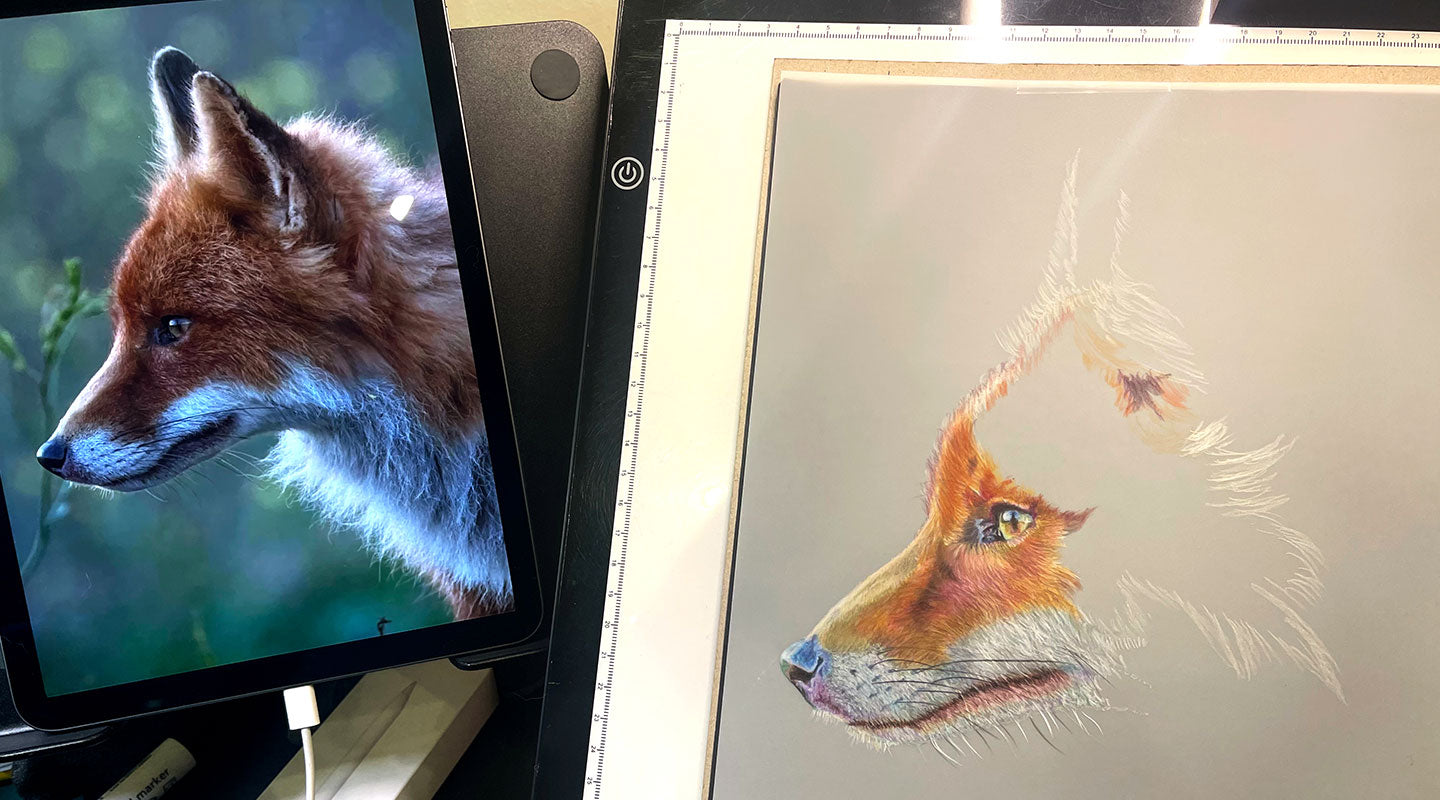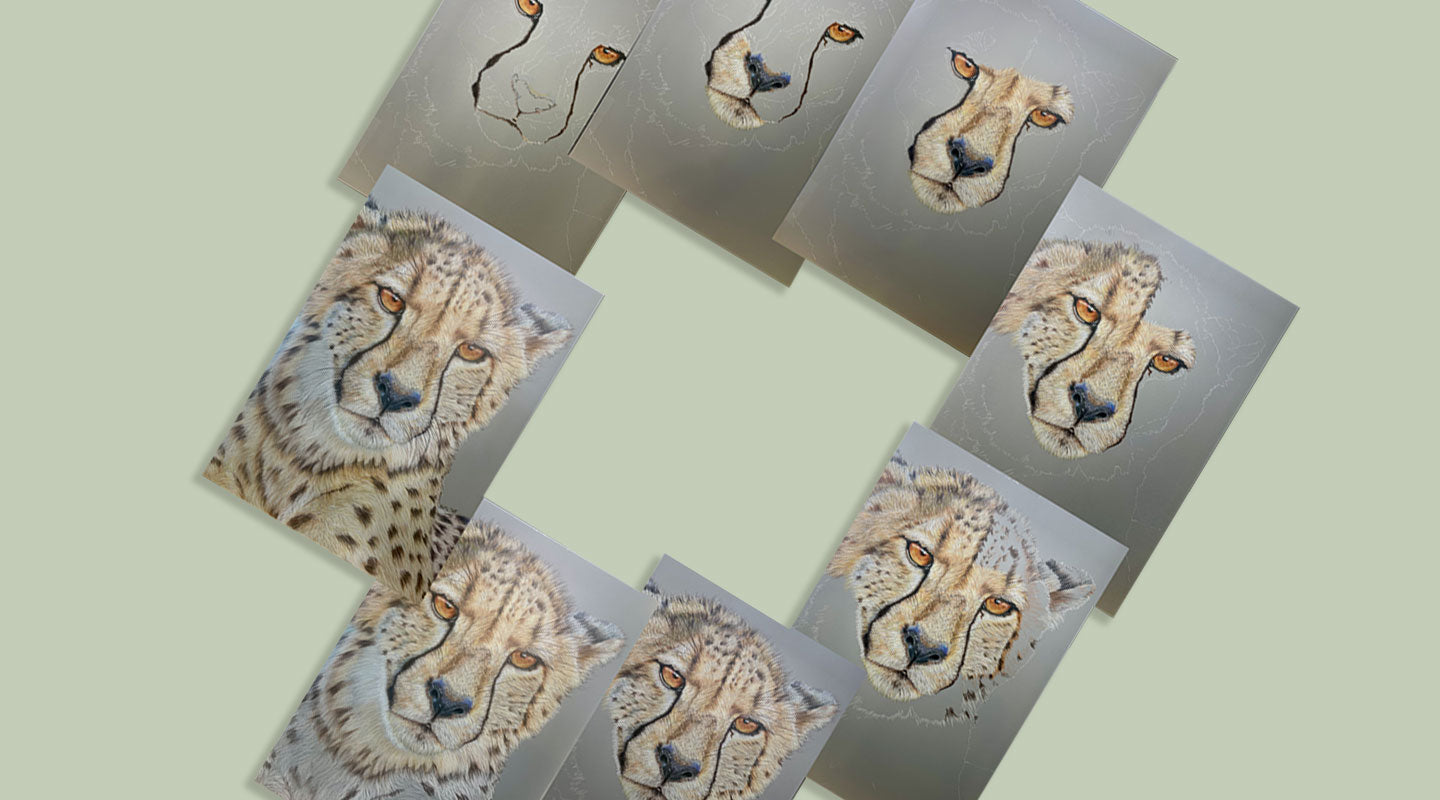Frequently Asked Questions
Can I have multiple pets in the one portrait?
This may be available in the future, but currently I only draw one pet per portrait to maintain the level of detail I can achieve on an A4 sized drawing.
Do you draw backgrounds in your commissions?
Generally, no, however this can be negotiated on request, and incur an additional $100 AUD.
How do I take the best photograph for a commission?
As mentioned in the Commissions tab, the quality of the reference photograph is the most important tool in creating a realistic interpretation of your pet, to capture its spirit and character, and achieve high levels of detail.
The photo needs to be in full focus (not portrait mode with blurring of extremities).
The photo must be of a high resolution, so that when you zoom in, you can see focused detail on your pet’s nose and individual hairs.
The photo should be a close-up of your pet’s face, or at least their whole body can take up the entire photograph, and I will crop it accordingly when arranging it into the A4 sizing. Avoid too much background.
Take the photo in natural lighting so your pet’s coat in the photo most represents their natural colour and is not obscured or flattened by shadow or direct sunlight. An overcast day outside is best.
Take the photo from eye-level with the animal.
Avoid using your flash so as to retain the natural colour of their eyes, and to allow the reflection of their surroundings to be seen in the eyeball.
Try to take the photo from an angle off-centre to give depth to their face.
Try to choose a number of poses that you find appealing, and best reflect their character and personality, so that I can select the one I find will best suit the A4 format and truly reflect your pet.
Can I order a commission of a wild animal from a photograph that I took?
You most certainly can! Please review advice on how to take the ideal photograph (in FAQ or the main Commissions text), and try to supply as many photographs as you can. If you only have the one photograph, and feel the quality of the image is sufficiently detailed when you zoom in, and is taken in good lighting, then this will be great. Please contact me (kerrymcloughlin2519@gmail.com) with your photograph before booking, so I can determine whether it is suitable to ensure I feel I can do it justice.
Do you offer international shipping?
I will offer international shipping, but would need to confirm your address and check with Australia Post as to the exact shipping cost before we proceed. Please contact me (kerrymcloughlin2519@gmail.com) to discuss shipping costs if you would like delivery outside of Australia.
How long does it take to receive a portrait?
Once I have received your 50% deposit and have finished my current art project, your commission will take 7-10 days for me to complete.
If you have selected local pick-up from Mulgrave, Victoria, I will then contact you to arrange a time for collection.
If you have selected postage (within Australia), allow another 5-7 business days for Australia Post to mail it to you, to be safe. I will notify you when it has been mailed and provide you with tracking details.
For international postage, please contact me (kerrymcloughlin2519@gmail.com) for an estimated time frame, depending on where you are based.
Do you offer framed commissions?
My commissions are mailed to you in a 30cm x 40cm matboard and backing board, in an acid-free sleeve, unframed.
If you would prefer it to be framed, I can arrange to place it in a budget frame with perspex, which is less likely to be damaged during postage. Please select the ‘framed’ option if you would prefer this. Framed drawings will incur an extra $100. Framed drawings will not be posted, only available for local pick-up in Mulgrave.
The ideal frame is one that has UV-resistant non-reflective glass, as this resists UV light that can potentially degrade the colour over time (if placed under direct sunlight), and avoid glare from ceiling lights and allow optimal viewing of the artwork. Such a frame would be available from a framing company.
What is your advice for caring for my pet portrait drawing?
Your artwork does not require the use of a fixative, and this should be avoided on pencil drawings.
Store your drawing in the airtight sleeve that it was placed in, as this avoids dust and keeps it protected.
It is best to frame as soon as possible, artwork must not touch the glass, and all materials should be acid-free.
When framing, only place a small strip of acid-free framing tape at the top of the drafting film to adhere it to the mount board (not all the way across, on the sides or the bottom) to allow for changes in temperature and warping.
Your coloured pencil portrait has been drawn with high quality pencils of high lightfastness ratings, that should retain their colour over many life-times. It has been drawn on Grafix drafting film, with a specific coloured piece of acid-free cardboard placed directly underneath the film to best bring out the colours of the drawing and show the fur in the way it was intended. You are most welcome to change the cardboard colour to your liking, bearing in mind that the colour directly underneath the drafting film highly affects the pencil colours drawn on the drafting film, and how light or dark the artwork appears generally. Backgrounds closer to white will make the fur strokes less distinct and also the white fur harder to distinguish, but they will make the artwork appear brighter generally and more blended.
The matboard provided is acid-free and has also been hand-picked by the artist to match the drawing tones ideally, but can be interchanged by others that your framer recommends if you decide you prefer other colours to better match your house/walls.
To save on money, should you choose an IKEA frame, your drawing has been mounted with a 30cm x 40cm matboard that fits perfectly into an IKEA frame, however this won’t have UV-resistant non-reflective glass.
Ideally frame your artwork behind UV-protected non-reflective glass, as this resists UV light that can potentially degrade the colour over time, and avoid glare from ceiling lights and allow optimal viewing of the artwork.
Make these considerations when choosing where to hang your artwork to avoid warping, discolouration, mildew and surface damage: avoid direct sunlight, frequent or large changes in temperature (open fires or radiators), high levels of humidity or damp (laundry, bathrooms or kitchen), and close to doors or other high-traffic areas.
What are your guidelines for hanging your artwork, to preserve their quality?
Avoid hanging artwork in direct sunlight as UV will bleach the colours (use UV-tinted film on windows and sheer fabric draped over windows in rooms with art if there is any concern, and direct sunlight cannot be avoided).
UV-blocking glass is ideal.
Avoid fluorescent lights.
Avoid hanging in areas with quick changes in, or high, humidity as this can lead to mould – near bathrooms, laundries or kitchens.
Avoid hanging in areas with quick changes in, or extreme, temperature – near kitchens or over actively used fireplaces; the larger the room, the more volume and slower the environment will change.
Store unhung art in a cool, dry, dark place.


